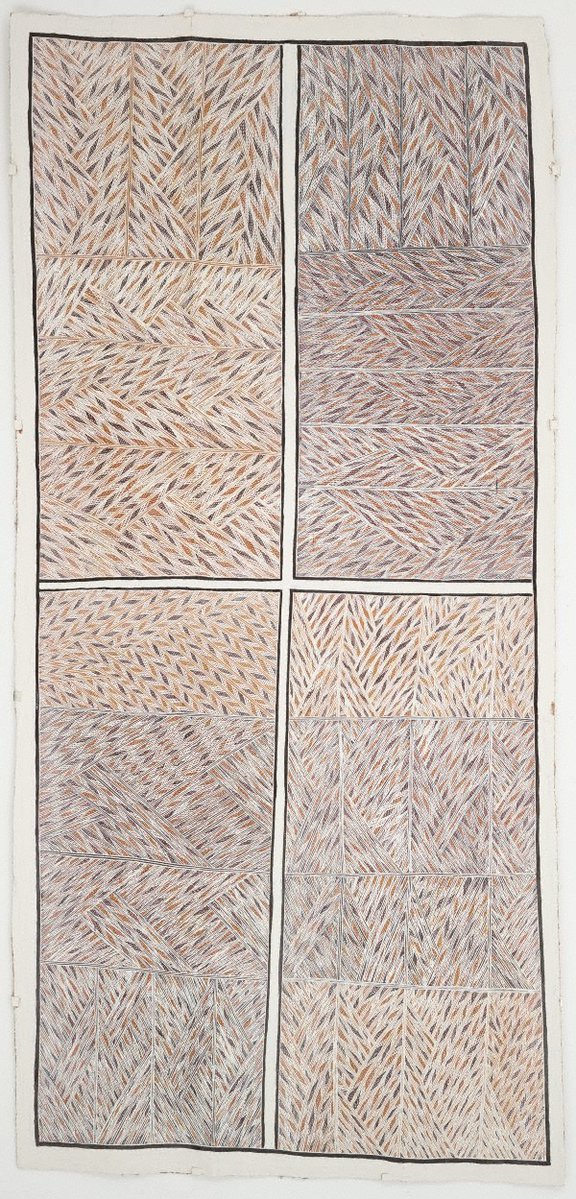Title
Djowuy
2005
Artist
-
Details
- Place where the work was made
-
Yirrkala
→
North-east Arnhem Land
→
Northern Territory
→
Australia
- Date
- 2005
- Media category
- Bark painting
- Materials used
- natural earth pigments on eucalyptus bark
- Dimensions
- 215.0 x 100.0 cm
- Credit
- Purchased with funds provided by the Aboriginal Art Collection Benefactors 2005
- Location
- Not on display
- Accession number
- 335.2005
- Copyright
- © Manman Wirrpanda courtesy Buku-Larrnggay Mulka Art Centre
- Artist information
-
Manman Wirrpanda
Works in the collection
- Share
-
-
About
The Buku Larnnggay Mulka documentation for the work states:
"The land that this work portrays is the artist's home in the Dhudi-Djapu clan estates around the meeting of the Dhuruputjpi River and the Yalata floodplain. It is a coastal area, this Dhudi-Djapu homeland, that has territory leading up a river through plains country behind the beach. The plain is tidal and during the wet seasons it is flooded by the rains and tidal surge creating areas of brackish water. During the dry season the grass and black earth dry out. Then the fires come, turning a swamp into a huge plain of cracked black earth. Fresh water springs dot this sun baked plain forming small islands of vegetation and as Rarrandada (the hot time) builds, the thirsty birds come to these sacred springs in their thousands. The noise of the gudurrku or dhangultji (brolgas) and gurrumatji (magpie geese) is deafening, the mud scored with their tracks and the sky dark with the flocks of wheeling birds.
In Ancestral times the activities of the Djang’kawu took place here. The Djang’kawu (the Dhuwa moiety creator beings), in naming this country for the Dhudi-Djapu, dug waterholes by plunging their sacred digging sticks in the ground creating waterholes as they did. Fresh water sprung from these wells as did a sacred goanna, a manifestation in some circles of the Djang’kawu themselves. Also on the wet clays around the wells the goanna observed the footprints of Dangultji (the brolga).
The majority of the painting is covered with the design which shows the salt tide bringing alimindirrk (mixed fresh and salt water) in through Djowuy – the mouth of this watercourse where it joins the Yirritja ocean (Munurru, Widiyarr) of Yathikpa. The design at this part of the painting shows the area Gurrkurrwuy or Yalata. The large name of this floodplain is Gara?arri. This area is broken up with Yolngu understanding into smaller areas. The structure of the songs and cosmology of this place is that the salt tide comes up first and then the rain washes it right back to the beach."
© Australian Art Department, Art Gallery of New South Wales, 2005
-
Places
Where the work was made
Yirrkala
-
Exhibition history
Shown in 1 exhibition
Our spirits lie in the water, Art Gallery of New South Wales, Sydney, 15 Nov 2014–01 Nov 2015
-
Bibliography
Referenced in 1 publication
-
Art Gallery of New South Wales, Art Gallery of New South Wales annual report 2006, 'Year in review: Aboriginal and Torres Strait Islander art', pg. 23-25, Sydney, 2006, 24.
-
